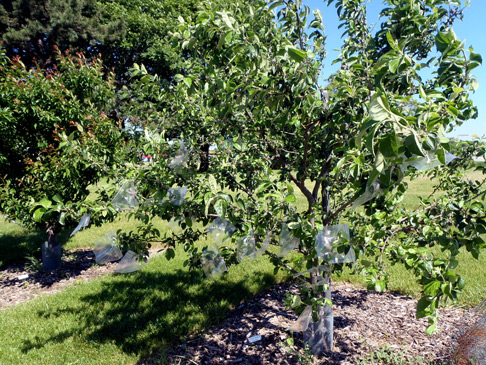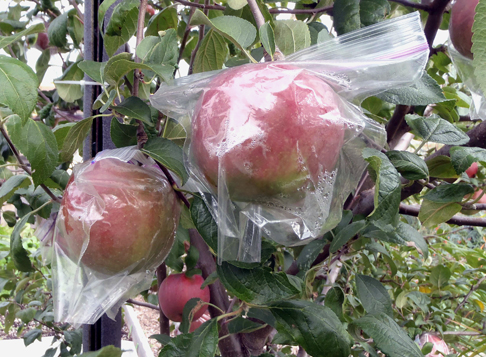As a new master gardener, I volunteer at the Channel 6 gardens on the north side of Milwaukee to fulfill my commitment to the group. Lead by Sharon Morrisey, a Consumer Horticulture Agent with Milwaukee County UW-Extension, our group meets every Thursday from 10 to noon in the Channel 6 garden. We work on planting, weeding and general upkeep. Originally I chose that volunteer opportunity because it was located on my side of town and I knew they mostly grew food. I hoped to learn better ways to grow food in my own garden while earning my volunteer hours.
Last week I learned about growing organic apples in the home garden. While the whole idea of growing organic food is very appealing, most gardeners have to deal with insect pests and sometimes using chemicals seems like the only solution. This organic growing method involves bagging the apples while they are still on the tree. The whole process starts with choosing a tree that is resistant to disease which of course was a decision made by the horticulturist. She chose Apple Malus Enterprise and when I started volunteering this spring, the tree was already growing nicely and was about 10 feet tall. The organic method of protecting your apples from insect pests is listed below.
Organic Bagging Process
Thinning
After the tree has finished blooming and the first small apples are about 1/2 to 3/4 inch, the fruit should be thinned to a single apple per cluster. This will help to produce large fruit and encourage return bloom next year. The concept here is that a tree can either grow a lot of small apples or fewer large apples.
Bagging
After thinning a cluster, a small quart size zip-lock baggy is placed over the apple and zipped up to the stem of the apple. A few small staples are inserted at the top of the bag to insure that the bag stays closed. The bottom two corners of the baggy are snipped off, leaving a place for any water to escape so the apple stays dry. The same process is repeated on the whole tree. This bagging will work for plums, pears and other larger tree fruits.
Bag Removal
Clear plastic bags do not impact fruit coloring and thus can be left on the fruit. If paper bags are left on the fruit until harvest, the fruit will not color properly. Even red apple varieties will be light yellow in color when ripe. So the paper bags need to be removed three weeks before harvest to allow the fruits to color properly.
Our horticulturist said that while commercial orchards use chemical sprays to deal with the insect pests, if you are dealing with one or two small trees and are intent on feeding your family organic fruit, this a great option.
The photo above shows our tree only partially done and I know that it looks strange festooned with baggies. However, when I talked to the volunteers who bagged this same tree last year, they said the apple tree produced beautiful fruit inside those bags. Each one was blemish free, looked perfect and no chemicals had been used on the apples. What a concept!
See Channel 6 demonstration of apple bagging






Pretty labor intensive!